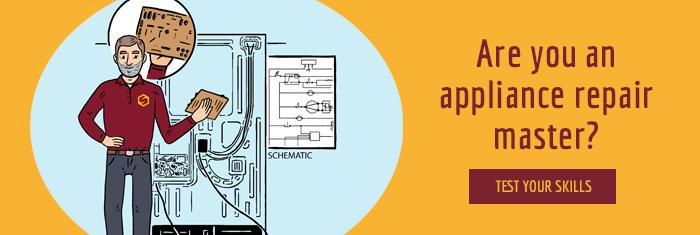Appliance Repair Pricing Systems: Comparing Flat Rate vs. Time and Materials
After reading a lively and long-lived discussion about flat-rate vs. time and materials pricing at another blog that Brother Durham brought to my attention, Mrs. Samurai felt The Calling to weigh in and write up her own opus magnum on the topic. We decided to post it here at my blog since she wants hers to be mostly about food, home, and health-related topics. So I'm posting it here under her by-line. It's a great read! Whether you're a professional appliantologist or a client of a professional appliantologist, I think you'll find it a thoughtful, informative, and fun read.
Appliance Repair Pricing Systems: Comparing Flat Rate vs. Time and Materials
by Mrs. Samurai,
www.MrsSamurai.comMost people are familiar with the “time and materials” method (TMM) of calculating the fees for in-home appliance repair, but a method called the “flat-rate system” (FRS) is gaining in popularity around the country. Many folks wonder how exactly the FRS works, and if one of these systems is better than the other. I’m gonna break it down for you, and go over the pros and cons of these systems.
Disclosure: Our service company, The Appliance Guru, uses the FRS. However, we don’t sell a flat-rate book or anything like that, so we don’t stand to gain one way or another with any particular recommendation. But since we researched this ourselves to arrive at our decision, I can share what we found out about both systems.
A summary of the Time and Materials method
The usual TMM fee for an in-home appliance service call is calculated by adding 3 basic pieces of information together: the service fee, the part(s) cost, and the labor charge.
The service fee is a set amount that is charged to cover the trip to the house and the effort and expertise it takes to diagnose the problem. (Some people refer to this as the fee to “come and look at it”, but that’s an absurdly simplistic way to describe the troubleshooting process!) Service fees for coming to diagnose most standard residential appliances may range from about $55 to $95, depending on the area.
The labor charge will be based on the actual time spent doing the repair multiplied by the hourly rate. This rate will also vary according to area, and should be disclosed up front. Also, there may be a minimum time that will be charged, such as a half hour. The part(s) cost will be a retail price, not the actual wholesale price that the servicer paid for the part.
Some experienced servicers are able to give a “not to exceed” quote on a repair beforehand, so the customer has an understanding of the upper limit of the cost of the repair and has some protection against unexpected time delays. Others do not do this and will just charge based on how long the repair actually takes.
What is the Flat-rate system?
Although the FRS is fairly new to the appliance repair scene, many other trades have used a similar system for a long time. Auto mechanics usually have standard “book rates” for certain tasks, rather than charging each customer the actual time (labor) it takes to do a repair.
The FRS is pretty straightforward. When the appliance servicer diagnoses the machine and determines what repair is needed, he will look up the fee for the particular repair in a book and then quote the customer that price for the repair. For example, if a widget on an ACME washer needs to be replaced, the servicer would look in the section for ACME washers, find the task “replace widget”, and the total cost for the completed repair will be listed beside it. There occasionally can be some add-ons if, for example, the washer is located in such a tight little closet that either it will take a lot more effort or a second man is required to help maneuver it so that it can be serviced, in which case a “difficult access” or “second man” charge will be added. There are also discounts that will be made if more than one task is performed during the same service call.
The main point of the FRS is that the exact cost of the repair is quoted up front to the customer, so that they can make a fully-informed decision about going forward with the repair. If a customer decides not to do the repair, then typically the servicer will charge a diagnostic or service fee of some amount that was disclosed up-front, similar to the service fee I mentioned in the TMM description.
How are the Flat Rates calculated?
The most common appliance repair flat-rate book on the market is called The Original Blue Book Major Appliance Job Rate Guide. According to the publisher’s website, the primary elements that comprise the rates in the guide are: “parts, time & labor, equipment, predictable and unpredictable circumstances surrounding specific jobs, inventory management, education/training, office staff, advertising, insurances, travel time to and from the customers home, and all service vehicle expenses.” (appliancebluebook.com)
Essentially, the FRS is similar to TMM in that the labor, time, and parts are all factored into the price for the repair. Similarly, an accurately determined labor rate for a TMM servicer will factor in all of the additional costs of doing business listed above. Obviously, in order to stay in business, any company needs to adequately price their services in order to cover all of the expenses involved, and since this can be a complicated calculation to make, the FRS is an attractive and easy pricing solution for repair companies.
What’s important in choosing a servicer
First of all, the pricing system that a service company uses is NOT the most important consideration the customer should make. Neither system will compensate for a technician who is incompetent, inconvenient, or dishonest. Either system can work well for a technician who runs a good business. The first things you should learn about a prospective appliance repair business is not the pricing, but rather their experience, convenience, guarantees, and the like. If they are a good company with well-trained technicians, then you will likely be charged a fair rate. It may not be the cheapest rate, but as we all know you usually get what you pay for.
Appliance repair - what you need to know about this trade
One other important point before we go into the pros and cons is that you should understand how the appliance repair trade is evolving, and how it is different from other skilled trades such as plumbing and electric.
For one thing, there are hundreds of different models of appliances out there. Having a reasonable inventory of parts along with all the technical bulletins, manuals, and other up-to-date information on all of these requires both time and financial resources to manage. A servicer who does not keep up with inventory and information will be less likely to be able to complete your repair in a timely or competent manner.
Also, the fact that modern appliances are getting increasingly complicated, particularly with all of the electronic control boards and advanced features, makes training and after-hours research a regular part of any technician’s schedule. Gone are the days when a general handyman or tradesman in another specialty can do a lot of appliance repair tasks quickly and effectively.
One other consideration is that the average day for an appliance repair tech involves many more trips between job sites as compared to a plumber or electrician. This extra time driving between jobs decreases the “billable hours” available during a typical weekday.
Because of these unique characteristics of the appliance repair trade, the rates for appliance repair (whether calculated via TMM or the FRS) often run higher than the hourly rates charged by different types of tradesmen such as plumbers or electricians.
Enough already! Which pricing system is better?
If all other qualities of an appliance repair company are equal, is one pricing system better than the other?
First of all, you should understand that in a sense both methods result in some degree of “averaging out” of the cost of jobs. Let me explain what I mean.
For example, the cost of a particular task charged by a company using the FSM will be the same no matter how slow or fast, experienced or inexperienced the technician. So every customer will pay essentially an averaged-out price for that repair. A widget replacement will cost $X regardless of whether it took the tech 10 minutes or an hour to complete it.
Alternatively, a TMM servicer will charge the exact same hourly rate for a repair regardless of the amount of training or expertise that particular repair requires. Hourly rates are calculated to adequately cover all costs of doing business, which includes ongoing training and equipment for increasingly complicated electronics and machines. Yet even the simplest of repair jobs will be charged the same hourly rate as the most complicated, even though plenty of repairs on older machines do not require particularly advanced skills, ongoing training, or expensive test equipment. The FRS is able to take these details into account for each particular job, whereas the TMM is not, because the FRS pricing takes into account the level of skill (training) required for a particular job, not just how long it takes to actually perform the task itself.
Here’s a summary of what customers like about flat-rate pricing:
- The exact repair cost is quoted up front, which makes the “repair or replace” decision easier to make and gives the customer more of a feeling of being in control of the situation.
- The standardization of prices prevents a price “penalty” for a slower technician or one who doesn’t have the part on the truck and will need to make a second trip.
- The knowledge that the price is an accurate reflection of the actual skills, effort, and equipment needed for that particular job is reassuring.
I would also point out something people might not think of - since the flat-rate prices are calculated very carefully to cover all of an appliance repair company’s expenses (including training to stay up-to-date on new appliances) and provide a living wage for the servicers, the businesses that use this system are more likely to stay in business for the long term. That’s important if you have found a company that you like! If your favorite tech throws in the towel because he just can’t make ends meet, then where are you?
Here’s what people like about time and materials pricing:
- Seeing the cost of the part and the labor itemized gives a feeling of transparency.
- Knowing how much a technician is charging hourly allows them to judge if they think it is reasonable, often by comparing to other servicers (as I mentioned earlier, this is generally not a valid comparison if you are comparing an appliance tech to someone in a different field, such as a plumber or electrician).
Is one method cheaper than the other?
There is no good reason that - on average - the prices for either method should be cheaper than the other if they are all based on covering all the costs of doing business. We happen to have had the opportunity to compare our “book prices” with those of other appliance repair companies who work in our area and found that the differences were generally not significant and there was no consistent pattern to who was more or less expensive.
The only reason that some people will find lower prices with a company using the TMM is that they are undercharging for their services (and thus at risk for going out of business) or are skimping in various ways, such as not being insured, not keeping a well-stocked inventory of parts, not staying current on training, not guaranteeing their work, not having a live human answer the phone, not doing same-day scheduling, etc.
The Bottom Line
Ultimately you should choose your appliance tech based on the level of service he provides, not how he charges. If price is your most important consideration, then you will likely have to sacrifice some amount of convenience and quality to get a lower price.
If you have a choice between two equally good repair companies with different pricing structures, then you can use the above comparisons to decide which one would suit your temperament best.
-
.png) 8
8
-
 1
1






4 Comments
Recommended Comments